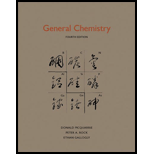
(a)
Interpretation:
The value of
Concept Introduction:
Here
The expression of ideal gas is as follows:
For change in volume of gas, equation (2) can also be written as follows:
Here,
Substitute
The expression to calculate difference between numbers of moles of product and reactant
Here,
(a)
Answer to Problem 14.83P
The value of
Explanation of Solution
The given chemical equation is as follows:
Total moles gaseous reactant
Total moles of gaseous product
Substitute 2 for
Substitute 1 for
The expression to calculate value of
Substitute
Substitute
(b)
Interpretation:
The value of
Concept Introduction:
Refer to part (a).
(b)
Answer to Problem 14.83P
The value of
Explanation of Solution
The given chemical equation is as follows:
Total moles gaseous reactant
Total moles of gaseous product
Substitute 1 for
Substitute
The expression to calculate value of
Substitute
Substitute
(c)
Interpretation:
The value of
Concept Introduction:
Refer to part (a).
(c)
Answer to Problem 14.83P
The value of
Explanation of Solution
The given chemical equation is as follows:
Total moles gaseous reactant
Total moles of gaseous product
Substitute 2 for
Substitute 0 for
The expression to calculate value of
Substitute 0 for
Hence value of
Want to see more full solutions like this?
Chapter 14 Solutions
General Chemistry
 ChemistryChemistryISBN:9781305957404Author:Steven S. Zumdahl, Susan A. Zumdahl, Donald J. DeCostePublisher:Cengage Learning
ChemistryChemistryISBN:9781305957404Author:Steven S. Zumdahl, Susan A. Zumdahl, Donald J. DeCostePublisher:Cengage Learning ChemistryChemistryISBN:9781259911156Author:Raymond Chang Dr., Jason Overby ProfessorPublisher:McGraw-Hill Education
ChemistryChemistryISBN:9781259911156Author:Raymond Chang Dr., Jason Overby ProfessorPublisher:McGraw-Hill Education Principles of Instrumental AnalysisChemistryISBN:9781305577213Author:Douglas A. Skoog, F. James Holler, Stanley R. CrouchPublisher:Cengage Learning
Principles of Instrumental AnalysisChemistryISBN:9781305577213Author:Douglas A. Skoog, F. James Holler, Stanley R. CrouchPublisher:Cengage Learning Organic ChemistryChemistryISBN:9780078021558Author:Janice Gorzynski Smith Dr.Publisher:McGraw-Hill Education
Organic ChemistryChemistryISBN:9780078021558Author:Janice Gorzynski Smith Dr.Publisher:McGraw-Hill Education Chemistry: Principles and ReactionsChemistryISBN:9781305079373Author:William L. Masterton, Cecile N. HurleyPublisher:Cengage Learning
Chemistry: Principles and ReactionsChemistryISBN:9781305079373Author:William L. Masterton, Cecile N. HurleyPublisher:Cengage Learning Elementary Principles of Chemical Processes, Bind...ChemistryISBN:9781118431221Author:Richard M. Felder, Ronald W. Rousseau, Lisa G. BullardPublisher:WILEY
Elementary Principles of Chemical Processes, Bind...ChemistryISBN:9781118431221Author:Richard M. Felder, Ronald W. Rousseau, Lisa G. BullardPublisher:WILEY





